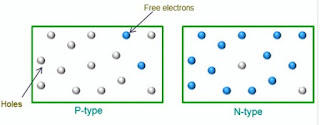What is Depletion Region ?????
What is depletion region?
Depletion means to reduction or decrease in quantity of something. For example, oil depletion refers to decrease in oil production from a particular oil well, region, or geographic area over a given time.
Similarly, in semiconductor physics, the depletion region refers to a region where flow of charge carriers are decreased over a given time and finally results in empty mobile charge carriers or full of immobile charge carriers.
P-type and n-type semiconductor
The p-type semiconductor is formed by adding trivalent impurities to the pure or intrinsic semiconductor while n-type semiconductor is formed by adding pentavalent impurities to the pure or intrinsic semiconductor.

In p-type semiconductors, holes are the majority
charge carriers while free electrons are the minority
charge carriers. On the other hand,
in n-type
semiconductors free electrons are the majority
charge carriers while holes are the minority charge
carriers.
Flow of free electrons and holes
If p-type semiconductor is joined with n-type semiconductor, a p-n junction is formed. The region in which the p-type and n-type semiconductors are joined is called p-n junction . This p-n junction separates n-type semiconductor from p-type semiconductor
In n-type semiconductors, large number of free electrons is present due to this they get repelled from each other and try to move from a high concentration region (n-side) to a low concentration region (p-side). Moreover, near the junction free electrons and holes are close to each other.
According to coulombs law there exist a force of attraction between opposite charges.
Hence, the free electrons from n-side attracted towards the holes at p-side. Thus, the free electrons move from n-side to p-side. Similarly, holes move from p-side to n-side.
Positive and negative charge at p-n junction
The free electrons that are crossing the junction from n-side provide extra electrons to the atoms on the p-side by filling holes in the p-side atoms. The atom that gains extra electron at p-side has more number of electrons than protons. We know that, when the atom gains an extra electron from the outside atom it will become a negative ion.
Thus, each free electron that is crossing the junction from n-side to fill the hole in p-side atom creates a negative ion at p-side. Similarly, each free electron that left the parent atom at n-side to fill the hole in p-side atom creates a positive ion at n-side.Negative ion has more number of electrons than protons. Hence, it is negatively charged. Thus, a net negative charge is build at the p-side of p-n junction. Similarly, positive ion has more number of protons than electrons.
Hence, it is positivelycharged. Thus, a net positive charge is build at n-side of the p-n junction.The net negative charge at p-side of the p-n junction prevents further flow of free electrons crossing from n-side to p-side because the negative charge present at the p-side of the p-n junction repels the free electrons. Similarly, the net positive charge at n-side of the p-n junction prevents further flow of holes from p-side to n-side.
Thus, immobile positive charge at n-side and
immobile negative charge at p-side near the
junction acts like a barrier or wall and prevent the
further flow of free electrons and holes.
The region
near the junction where flow of charges carriers are decreased over a given time and finally results in empty charge carriers or full of immobile charge carriers is called depletion region.The depletion region is also called as depletion zone, depletion layer, space charge region, or space charge layer. The depletion region acts like a wall
between P and N region.
Thanks
Like and Share ....


Comments
Post a Comment